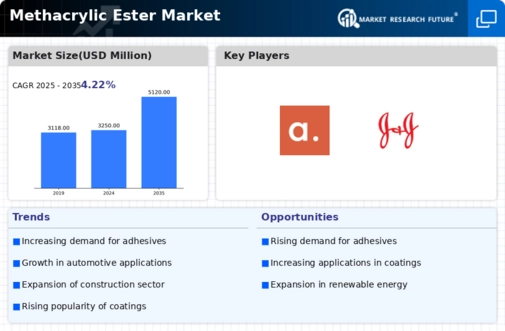Top Industry Leaders in the Methacrylic Ester Market
 Methacrylic esters (MEs), versatile organic compounds lauded for their exceptional properties, are painting a vibrant picture in diverse industries. These high-performing monomers boast excellent adhesion, durability, and weather resistance, making them invaluable for numerous applications like coatings, adhesives, and construction materials. Navigating this competitive landscape, however, requires mastering the brushstrokes of strategic positioning.
Methacrylic esters (MEs), versatile organic compounds lauded for their exceptional properties, are painting a vibrant picture in diverse industries. These high-performing monomers boast excellent adhesion, durability, and weather resistance, making them invaluable for numerous applications like coatings, adhesives, and construction materials. Navigating this competitive landscape, however, requires mastering the brushstrokes of strategic positioning.
Key Strategies Shaping the Market:
-
Product Diversification: Leading players like BASF, DowDuPont, and Evonik are expanding their ME portfolios, tailoring formulations to specific end-use requirements. This differentiation caters to niche markets and fosters customer loyalty. -
Vertical Integration: Securing control over critical raw materials like methacrylic acid is crucial for ensuring stable supply chains and cost competitiveness. Companies like U-PICA are pursuing vertical integration, gaining upstream advantage. -
Technological Advancements: Continuous research and development in green synthesis methods and novel ME applications are vital for sustained growth. Sigma-Aldrich's recent breakthrough in bio-based MEs exemplifies this innovative endeavor. -
Geographic Expansion: Emerging economies like China and India present significant growth potential. Companies like Asahi Glass and Dongyue Group are strategically building production facilities in these regions to capitalize on the rising demand. -
Sustainability Focus: Environmental concerns surrounding volatile organic compounds (VOCs) are pushing manufacturers towards low-VOC and bio-based ME alternatives. Covestro's initiatives in eco-friendly MEs demonstrate this commitment to sustainability.
Factors Dictating Market Share:
-
Brand Reputation and Reliability: Established players with proven track records like Eastman Chemical Company and Arkema enjoy significant market share due to their brand recognition and consistent quality. However, innovative startups addressing specific applications can still emerge as niche players. -
Cost Competitiveness: Optimizing production processes and sourcing affordable raw materials are crucial for cost leadership. Asian manufacturers often have an edge due to lower labor costs, but premium brands command higher prices due to superior functionality and reliability. -
Distribution Network and Customer Service: Extensive distribution networks and prompt technical support are essential for customer satisfaction and repeat business. Companies like Mitsubishi Chemical excel in this area. -
Regulatory Landscape: Stringent environmental regulations, especially in Europe and North America, are pushing manufacturers towards low-VOC and bio-based ME alternatives. Adapting to evolving regulations and developing compliant products becomes crucial for market success.
Key Players:
- BASF SE (Germany),
- The Dow Chemical Company (U.S.),
- Evonik (Germany),
- U-PICA Company.Ltd. (Japan),
- Sigma-Aldrich Co. LLC. (U.S.),
- MITSUBISHI GAS CHEMICAL COMPANY, INC. (Japan),
- Fushun Anxin Chemical Co., Ltd. (China),
- NOF CORPORATION. (Japan),
- Michelman, Inc. (U.S),
- Lucite International (UK)
Industry News and Recent Developments:
August 2023: DowDuPont collaborates with a leading automotive manufacturer to develop a new ME-based adhesive for lightweight car body components, contributing to fuel efficiency.
October 2023: The Indian government announces plans to invest in building high-performance infrastructure using methacrylate-based composites, boosting demand for MEs in the construction sector.
November 2023: The European Union proposes stricter VOC emission regulations for adhesives and sealants, posing a challenge for conventional ME manufacturers but prompting development of low-VOC alternatives.
December 2023: Asahi Glass successfully commercializes a novel ME with enhanced scratch resistance, targeting high-traffic surfaces in commercial and residential buildings.

